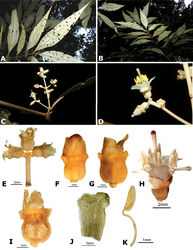Conostegia centrosperma
| Notice: | This page is derived from the original publication listed below, whose author(s) should always be credited. Further contributors may edit and improve the content of this page and, consequently, need to be credited as well (see page history). Any assessment of factual correctness requires a careful review of the original article as well as of subsequent contributions.
If you are uncertain whether your planned contribution is correct or not, we suggest that you use the associated discussion page instead of editing the page directly. This page should be cited as follows (rationale):
Citation formats to copy and paste
BibTeX: @article{Kriebel2016PhytoKeys, RIS/ Endnote: TY - JOUR Wikipedia/ Citizendium: <ref name="Kriebel2016PhytoKeys">{{Citation See also the citation download page at the journal. |
Ordo: Myrtales
Familia: Melastomataceae
Genus: Conostegia
Name
Conostegia centrosperma (Almeda) Kriebel comb. nov. – Wikispecies link – Pensoft Profile
- Conostegia centrosperma (Almeda) Kriebel. Basionym: Miconia centrosperma Almeda, Brittonia 35(1): 42, f. 1. 1983. Type: Panama. Panamá: along newly cut road from El Llano to Carti-Tupile, 3 mi above Pan-Am Highway, elev. 200 m, 13 March 1973, R. L. Liesner 702 (holotype: CAS!; isotypes: MO!, US).
Description
Small trees 3–7 m tall with flattened and two edged stems when young that become terete with age and which are reddish brown and densely stellulate-lepidote on young branches; the nodal line nodal line evident. Leaves at a node equal to subequal in length. Petiole 0.5–2 cm. Leaf blades 5.25–12.5 × 1.5–4.5 cm, 3-plinerved, with the inner pair of primary nerves diverging from the mid vein 0.4–3 cm above the blade base in opposite, subopposite or alternate fashion, elliptic to elliptic lanceolate, the base acute to decurrent on the petiole, the apex acuminate, the margin entire or slightly denticulate, the adaxial surface glabrous, the abaxial surface reddish brown and densely stellulate-lepidote. Inflorescence a terminal little branched panicle 1.6–4.8 cm long with the branches terminating in three sessile-flowered clusters, accessory branches mostly absent, bracteoles 3–4 mm long, linear-oblong, early deciduous. Floral buds ca. 4–5 × 2–3 mm, campanulate to urceolate. Flowers 5-merous, not calyptrate, but with the calyx lobes fused in bud and rupturing at anthesis (with the style sticking out initially) into irregular persistent lobes ca. 2 mm long, the calyx teeth obsolete or evident as blunt protuberances at or near the torus, the hypanthium 2–3 × 2–3 mm, densely reddish brown and densely stellulate-lepidote. Petals 3.75–4.25 × 2–2.5 mm, white, oblong-obovate, spreading, glabrous, truncate to asymmetrical apically. Stamens 10, 4.5–5.25 mm long, radially arranged around the style, the filament 2.5–3.25 mm, with a geniculation near the apex, white, anthers 1.5–2 × 0.5–0.75 mm, linear oblong, yellow, laterally compressed, the pore ca. 0.2 mm, terminal. Ovary 5-locular, inferior, costate apically and forming a setose collar around the style. Style 6–6.5 mm, exserted and straight, vertical distance from the anther to the stigma ca. 1.75–2 mm from the stigma, horizontal distance absent, the stigma truncate to slightly expanded, 0.65–0.85 mm wide. Berry 3–4 × 3–4 mm, purple black. Seeds ca 0.5 mm, cuneate, angularly ridged with a conspicuous spur on the distal truncate surface.
Distribution
(Fig. 142). Endemic to central Panama where it has been collected in the foothills of Cerro Jefe and El Llano Cartí Road, 200–750 m elevation. Almeda (1983)[1] compared Conostegia centrosperma to Conostegia xalapensis in the protologue, a species from which Conostegia centrosperma differs by its non-calyptrate calyx, more lepidote than stellate indument, exserted style, and setose rim around the style base. Almeda (1983)[1] also compared Conostegia centrosperma to Conostegia fulvostellata and Conostegia oligocephala which interestingly also belong to section Geniculatae. These two species differ from Conostegia centrosperma in their non rupturing calyx and stellate indument. When Almeda described Conostegia centrosperma, Conostegia dissitinervia had not been described. When Conostegia dissitinervia was described (Kriebel et al. 2005[2]) its possible relationship to Conostegia centrosperma was discussed and both taxa were separated in a dichotomous key. These two species form a strongly supported sister pair in the molecular phylogenetic analyses. They can be distinguished by the larger leaves with stellate indument abaxially and longer inflorescences in Conostegia dissitinervia. In addition to the hyaline calyx of the latter when rupturing, does not leave the evident calyx lobe pieces of Conostegia centrosperma. Lastly, Conostegia dissitinervia lacks the setae around the style base present in Conostegia centrosperma and has an apiculate anther apex that Conostegia centrosperma lacks.
Specimens examined
PANAMA. Panamá: P.N. Chagres, sendero El Mono, adentro de la urbanización Altos de Cerro Azul, Kriebel and Burke 5690 (NY, PMA); vicinity of Cerro Jefe, McPherson 10004 (CAS); El Llano Cartí Road, 8.5 km from Inter-American Hwy, Mori et al. 4546, 5142 (CAS).
Taxon Treatment
- Kriebel, R; 2016: A Monograph of Conostegia (Melastomataceae, Miconieae) PhytoKeys, (67): 1-326. doi
Images
|
Other References
- ↑ 1.0 1.1 Almeda F (1983) Three new mesoamerican species of Miconia (Melastomataceae). Brittonia 35(1): 42–48. doi: 10.2307/2806048
- ↑ Kriebel R, Almeda F, Estrada A (2005) Two new species of Melastomataceae from southern Mesoamerica. Proceedings of the California Academy of Sciences 56(27/37): 675–683.

